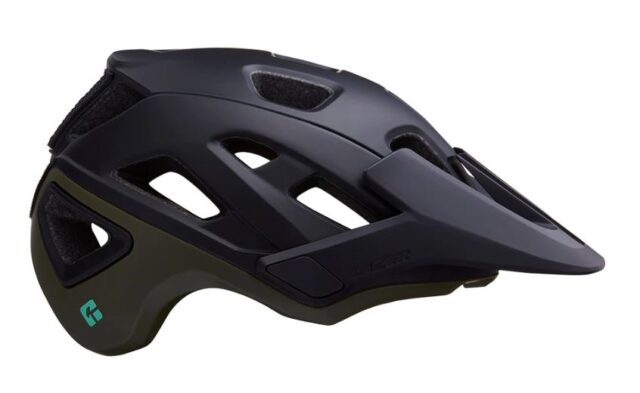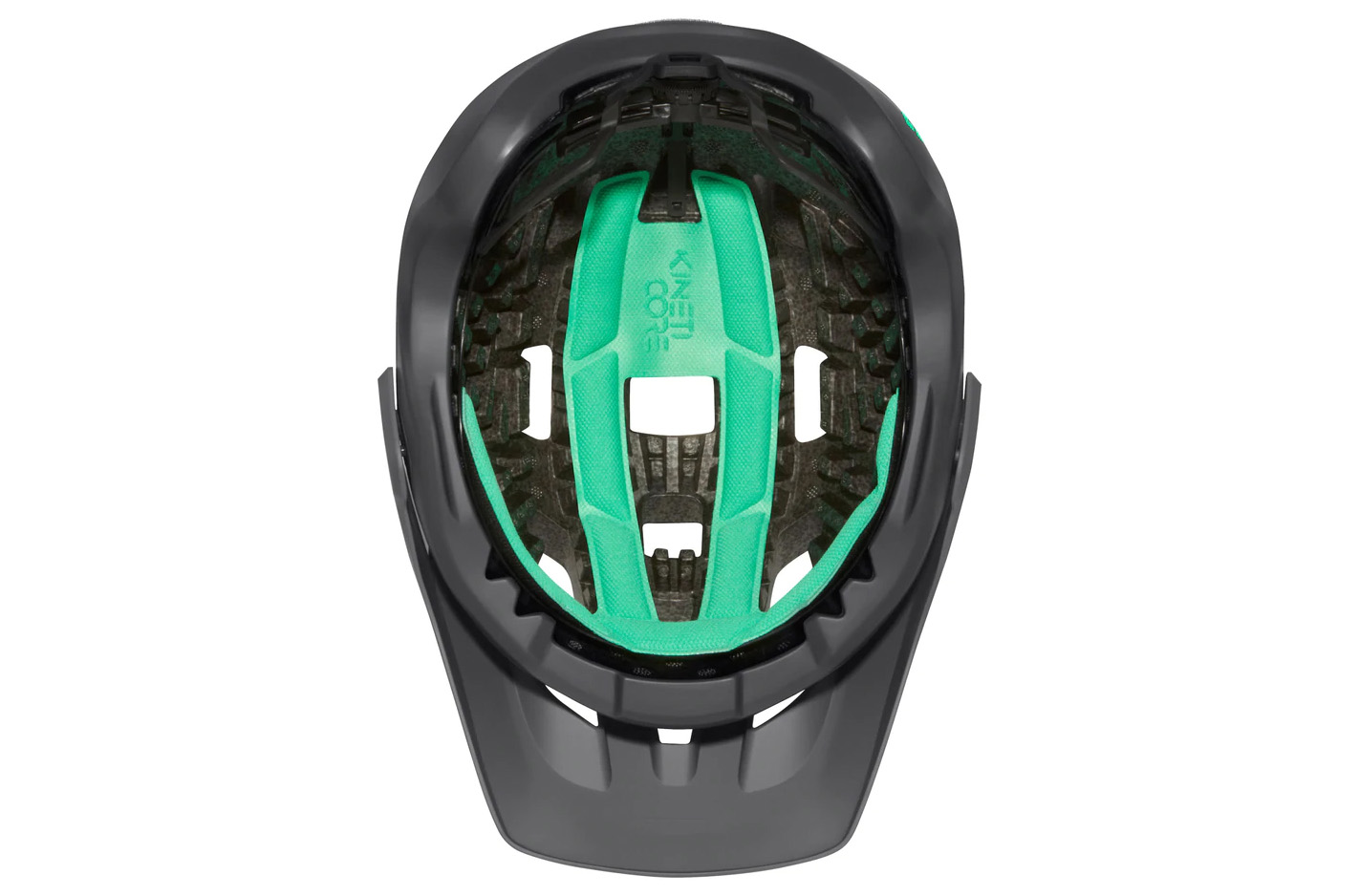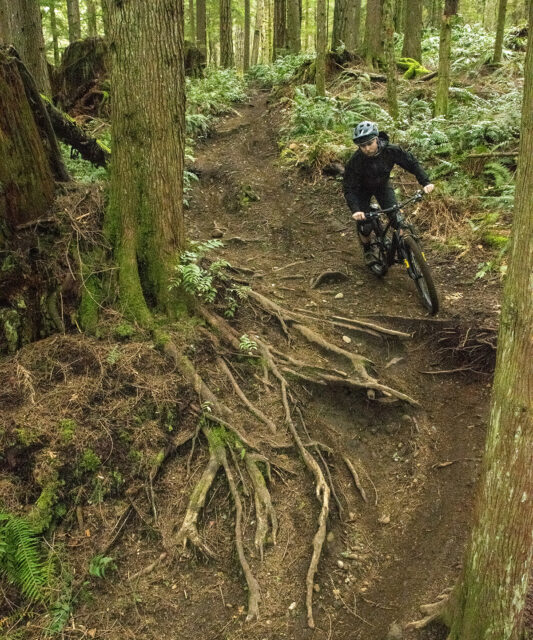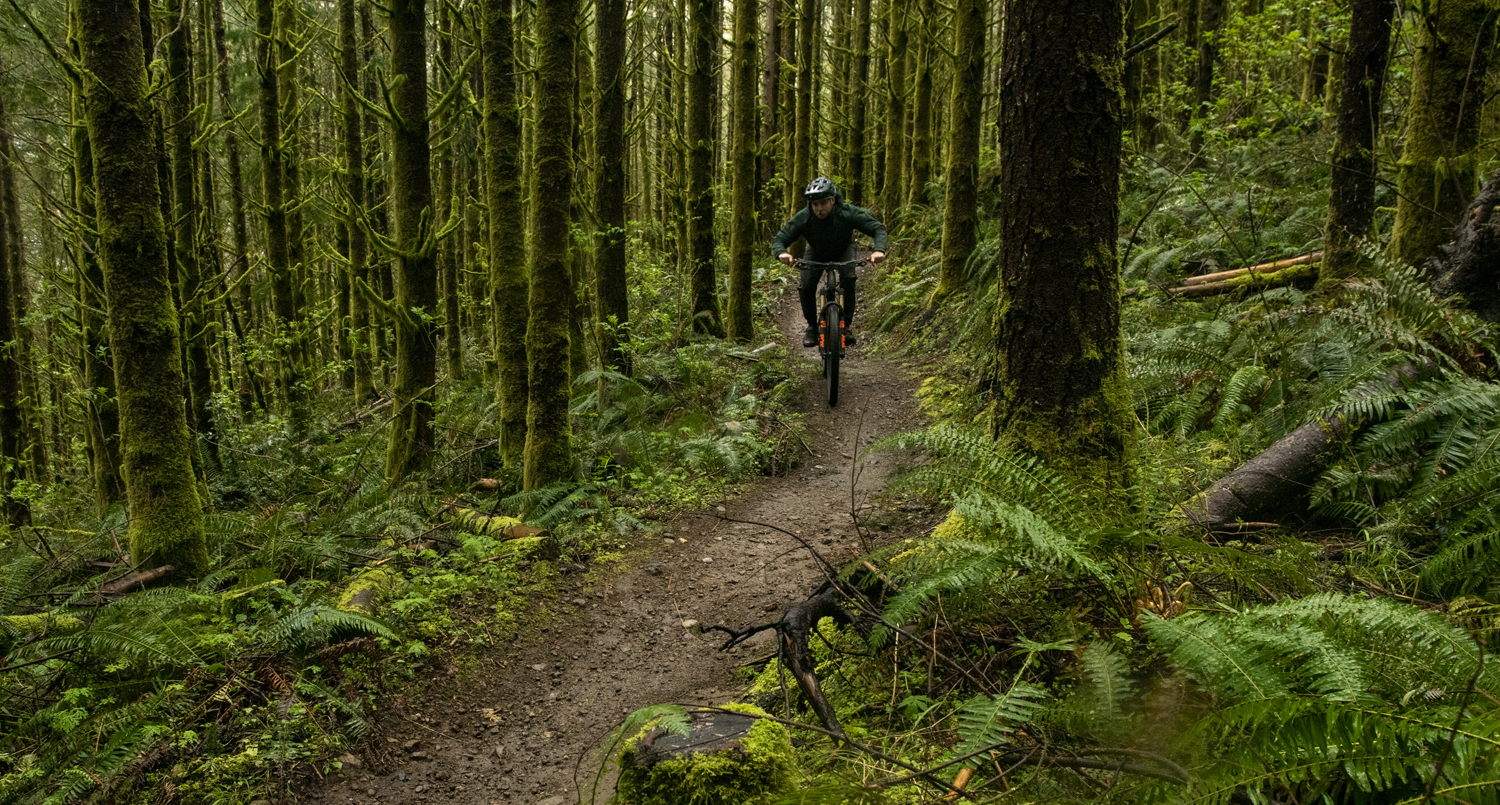Lazer Jackal KinetiCore
Size Tested: Large
MSRP: $220
Blister’s Measured Weight (size L): 401 grams
Test Location: Washington
Test Duration: 2 months

Intro
Rotational impact protection has been a real point of emphasis in mountain bike helmets over the last few years, with MIPS leading the charge on that front. Lazer launched their new KinetiCore technology a few months ago, with the goal of accomplishing a similar level of protection as MIPS while minimizing its downsides — namely, using less plastic, saving weight, improving ventilation, and reducing the feeling of the helmet moving around on the rider’s head as the shell moves separately from the liner.
I went a whole lot deeper on the subject with Lazer’s Chris Smith back in Episode 112 of Bikes & Big Ideas, and having now spent a couple of months testing their Jackal KinetiCore helmet, I think the technology is quite compelling.

Design & Features
The biggest story with the Jackal is the KinetiCore technology itself. In short, the goal is to allow the helmet to rotate slightly on the rider’s head when they hit the ground, to reduce the likelihood and severity of traumatic brain injuries. The idea is that, if the helmet shell can rotate somewhat, it’ll impart less force to the head by helping to mitigate the rotational acceleration that occurs due to the helmet not sliding 100% friction-free against the ground or whatever else you might be unfortunate enough to run into.
Traditionally, most technologies with that goal in mind — MIPS being the frontrunner in that space — have gone about the problem by adding a plastic liner between the helmet padding and the shell, which can rotate between the helmet shell and the rider’s head and provide a degree of movement there. But such a system has downsides — adding a plastic liner to the helmet adds weight, can block or otherwise limit ventilation, and in a lot of cases causes some noticeable movement of the helmet shell under normal riding conditions. And so Lazer went back to the drawing board and came up with KinetiCore — a deceptively simple way of taking on the same goal.
Instead of incorporating a plastic liner that can move all of the time, Lazer molded a carefully designed series of blocks and channels into the EPS foam shell (the standard expanded foam that most bike helmets are constructed from), which, due to the open channels, have room to deflect laterally in the event of a crash that imparts some rotational energy into the helmet. But by getting rid of the plastic liner, Lazer says that they’re able to cut a significant amount of weight, use less plastic in the helmet, improve ventilation, and do away with the feeling of the helmet moving on your head that you can get with MIPS.

Lazer isn’t making any wild claims about KinetiCore being more protective than MIPS or anything like that; rather, they say that it’s similarly effective while bringing all of the other benefits that we’ve just laid out when it comes to comfort and so on. And it’s worth noting that the Jackal KinetiCore has received a 5-star rating from Virginia Tech’s helmet testing lab, the highest score that they offer.
The Jackal KinetiCore also comes with a GoPro-style accessory mount, which interlocks with one of the top vents and attaches to the helmet with a velcro strap. Lazer also made a point of ensuring that the Jackal would pass all the relevant safety standards with the mount installed and an accessory on it — it’s possible for those sorts of mounts to punch through the shell of a helmet in the event of a crash, and Lazer has reinforced the Jackal KinetiCore to prevent that. I’ve occasionally used the mount for lights and it works very well — installing it is fairly easy, and it’s very secure and well-positioned. The only downside is that it doesn’t feature a quick-release for the accessory itself, so if you’re swapping between a light and a camera (or whatever else), you’ll need to take a minute to screw on the other accessory. I’ve just left the mount attached to my light and installed it on the helmet as needed, which works great.
The other features of the Jackal KinetiCore are pretty standard for a high-end mountain bike helmet — it’s got a three-position adjustable visor, a dial fit-adjustment system (which Lazer calls TurnSys), and a FidLock magnetic buckle. There’s a rubber gripper on the back for a helmet strap, and recesses built into the temple area of the helmet to better accommodate sunglasses frames comfortably.
Fit
The fit of the Jackal KinetiCore feels fairly middle-of-the-road in terms of head shape — it’s not quite as round as the POC Kortal, Fox Speedframe Pro, or (especially) the Giro Manifest Spherical, but a little more so than the Smith Forefront 2. The coverage is solid for a modern Trail/Enduro open-face helmet, which have been growing increasingly burly in recent years. It’s definitely not as big and full-coverage-feeling as options like the POC Kortal / Kortal Race MIPS, or (to a lesser extent) the Fox Speedframe Pro, but the Jackal KinetiCore also feels significantly lower-profile and a bit lighter than either. In that regard, it’s pretty similar to the Forefront 2 — one of the lighter, more compact-feeling helmets in the class.

The fit on my head, which trends a bit on the oval side but doesn’t generally give me much trouble in most size Large helmets, is good; if anything the interior of the shell starts to slope down into the back of the helmet just a tiny bit too quickly across the back of the crown for my exact head shape, but not to the point where it was notably uncomfortable or gave me any real trouble. We’d always recommend trying on a helmet before buying, but Lazer does offer free returns and exchanges for online orders, and the fit does feel fairly average — there’s nothing too weird going on here.
The TurnSys dial retention system does a nice job of snugging up the helmet without any pinching or hot spots, and has an especially easy-to-use dial, even with gloved fingers. That’s largely due to the fact that the dial is relatively large and protrudes from the back of the helmet a little more than most, but I don’t imagine that’ll be a problem for most people. It’s also very easy to adjust the vertical positioning of the retention system — maybe too easy. I found myself accidentally moving the anchor point fairly often as I took the helmet on and off. Getting it reset only took a moment and is easy to do with the helmet on your head, but it’d be nice to see some firmer detents on that particular adjustment.
On The Trail
I’ve often complained about certain implementations of MIPS liners moving perceptibly on my head and/or making noise, and KinetiCore solves both of those problems completely. I’m particularly sensitive to feeling the helmet shell sliding around on my scalp (probably at least in part because I keep my head shaved), and doing away with that movement is extremely welcome. Now, there are certain implementations of MIPS systems that achieve the same effect — notably the POC Kortal Race MIPS and Giro Manifest Spherical — but those are more the exceptions than the rule. And the Jackal KinetiCore does feel notably light and low-profile for this class of helmet, too. Its actual measured weight (401 g @ size Large) isn’t especially low, but I think due to the combination of being comparatively low-profile and not having the added movement of a MIPS liner, the Jackal KinetiCore feels fairly light, particularly when turning your head quickly.
Its ventilation is also quite good — it’s up there with the Fox Speedframe Pro for the coolest, best-ventilated option I’ve used in this class. The Speedframe Pro probably still edges it out by a hair, but it’s close. The Jackal KinetiCore’s internal padding is also especially effective at stopping sweat dripping down my face — the swath of padding across the brow is a bit thicker and more absorbent than most helmets I’ve tried in recent memory, and makes a real difference in keeping sweat out of my eyes. The visor is fairly average in size and features three positions of adjustability. It’s easy to move, but still stays in place just fine while on the bike — no complaints there. While I’ve come to appreciate the especially large visor on the POC Kortal Race MIPS for helping keep water off my eyewear when riding in the rain, the one on the Jackal feels adequate most of the time.
Overall, the Jackal KinetiCore is a nicely thought out, comfortable helmet that feels relatively lightweight and low-profile for this sort of Trail-oriented option, and that’s a compelling combination of traits. The unwanted movement of the retention system anchor when putting the helmet on is the only real complaint that I’ve got, and it’s a fairly minor one, since getting the anchor repositioned is so easy.

Bottom Line
The Lazer Jackal KinetiCore is a nicely designed Trail-bike helmet with above-average ventilation, good comfort, a fairly middle-of-the-road fit that should work for a lot of people, and a 5-star safety rating from Virginia Tech’s helmet testing lab. And in terms of the comfort-oriented claims that we’re capable of testing, the KinetiCore technology at the heart of the helmet delivers. It’s a really nice option, particularly for folks who’d prefer a relatively lightweight, low-profile helmet.

I’d own this helmet if they offered it in a hi-viz color, which is all I use, for a variety of reasons.
Currently running a bright orange Speedframe Pro, which is almost perfect. The bobble-head MIPS effect kind of disappears from my brain after 5 minutes on the bike, and it’s a really cool helmet on hot days, but the brow padding is so-so at best (rectified by my seamstress wife).
I’ve got an older Bontrager Rally MIPS that is perfect in all regards, except it runs a little warm.
The endless quest……. :-)